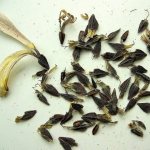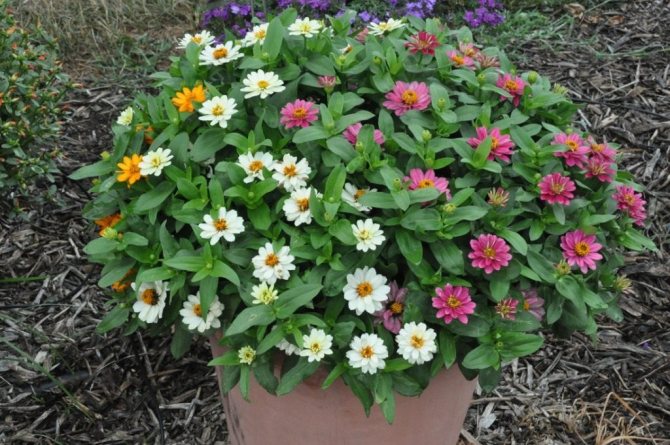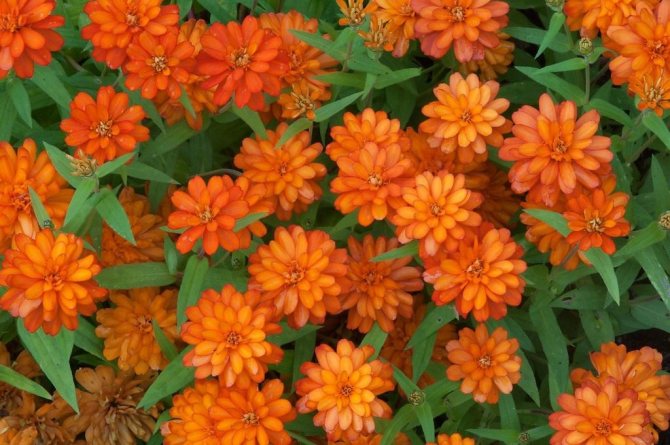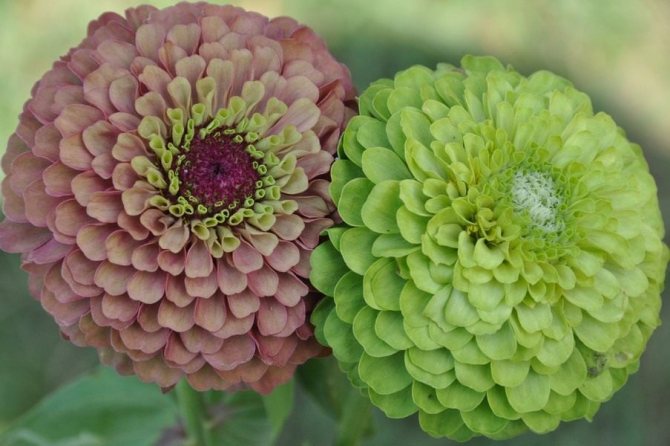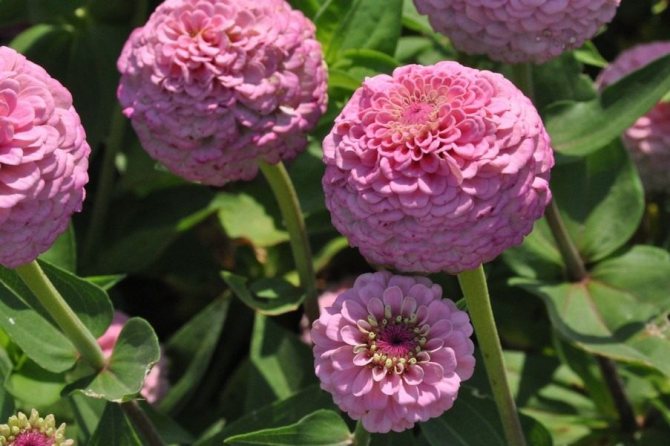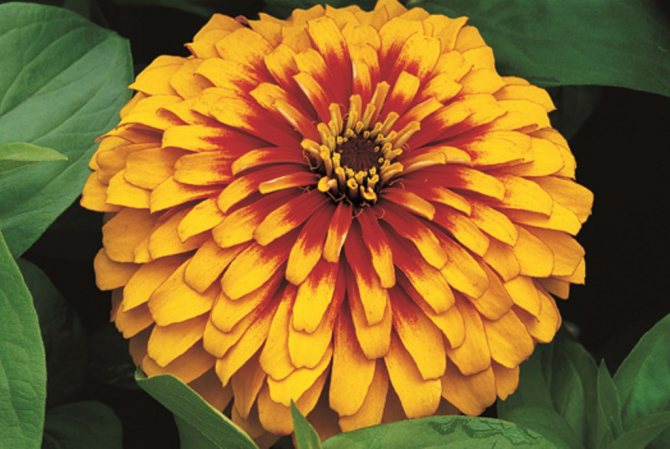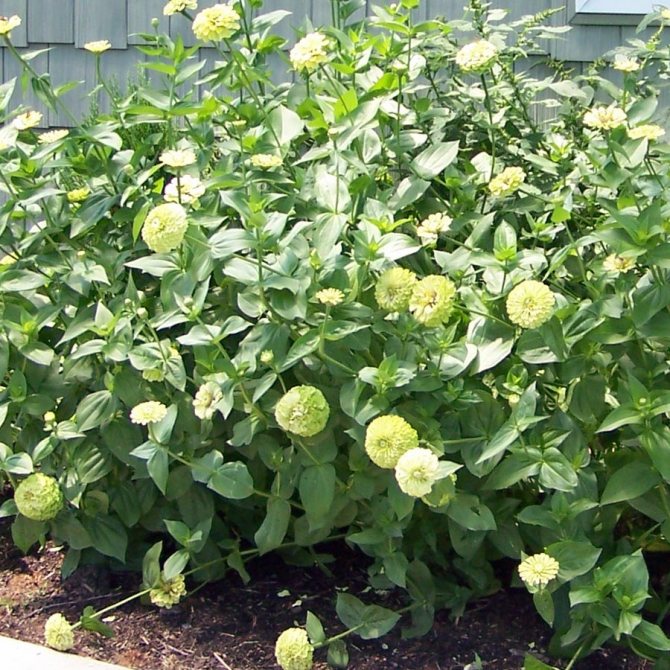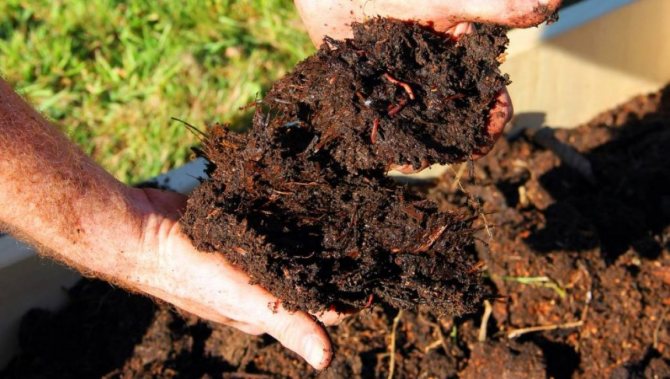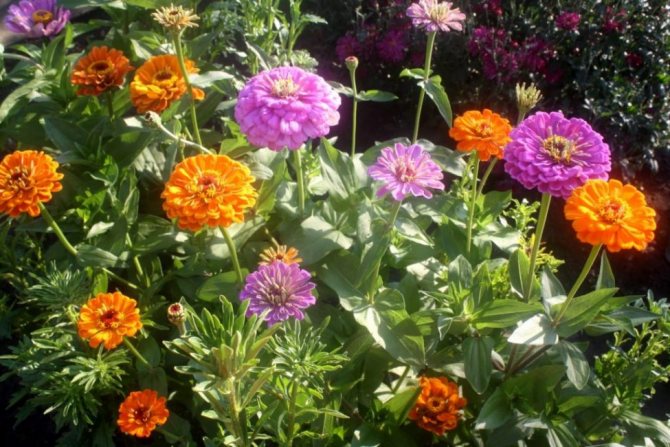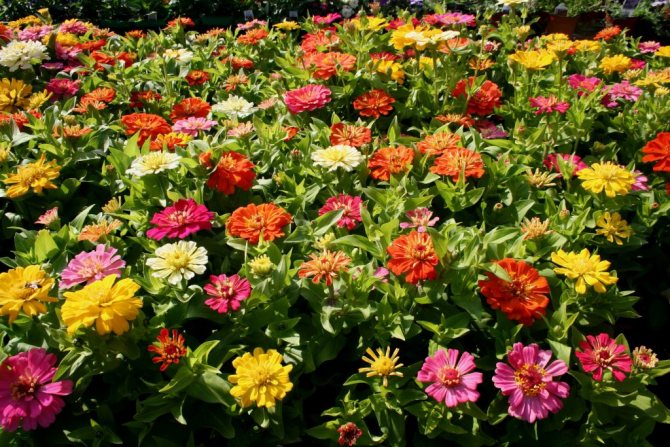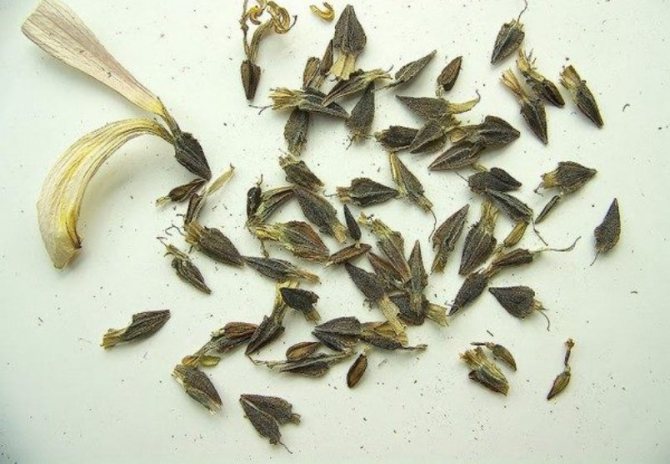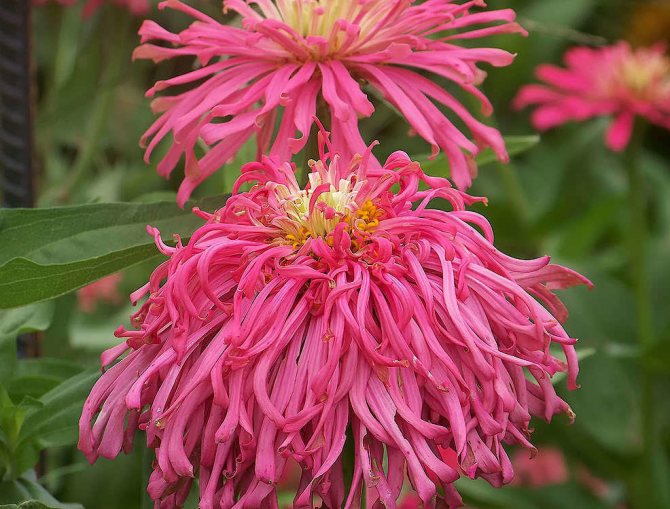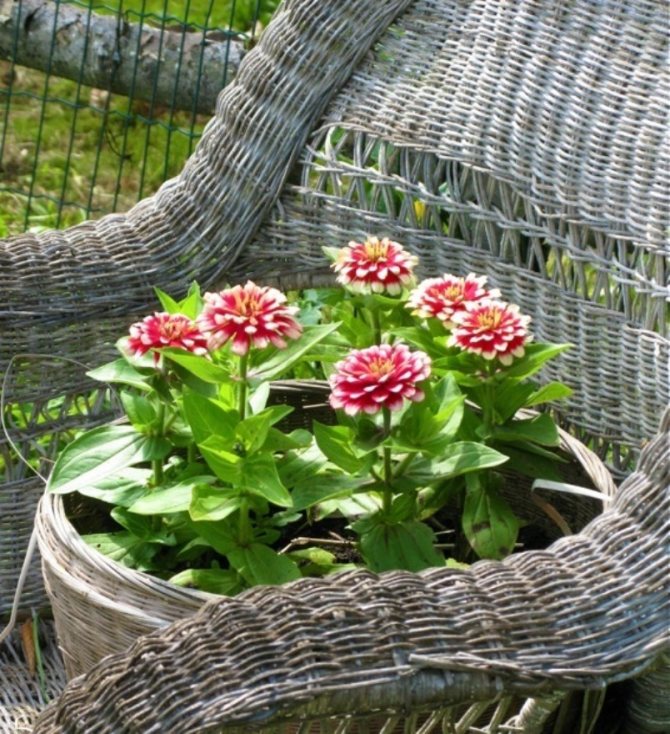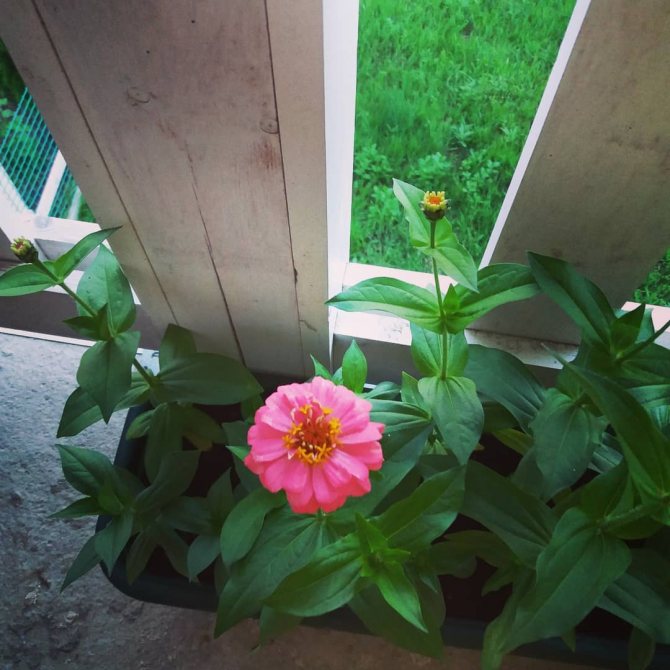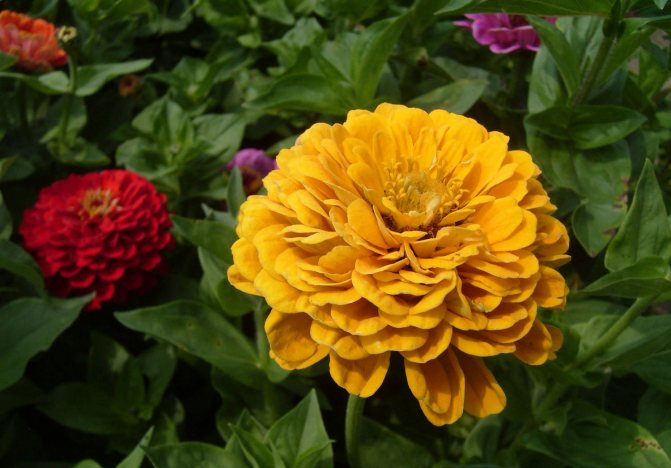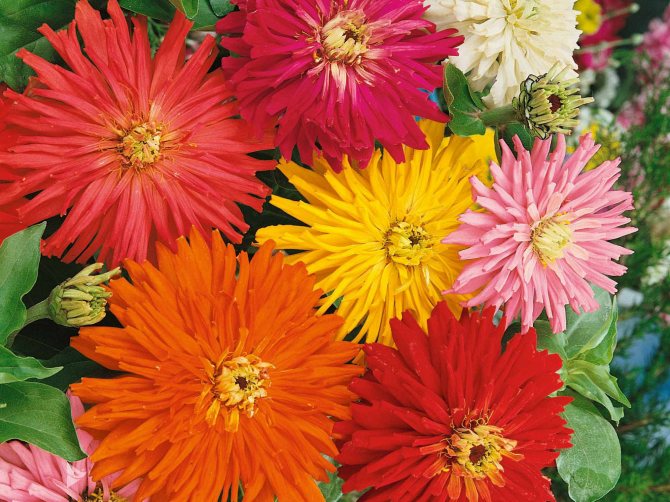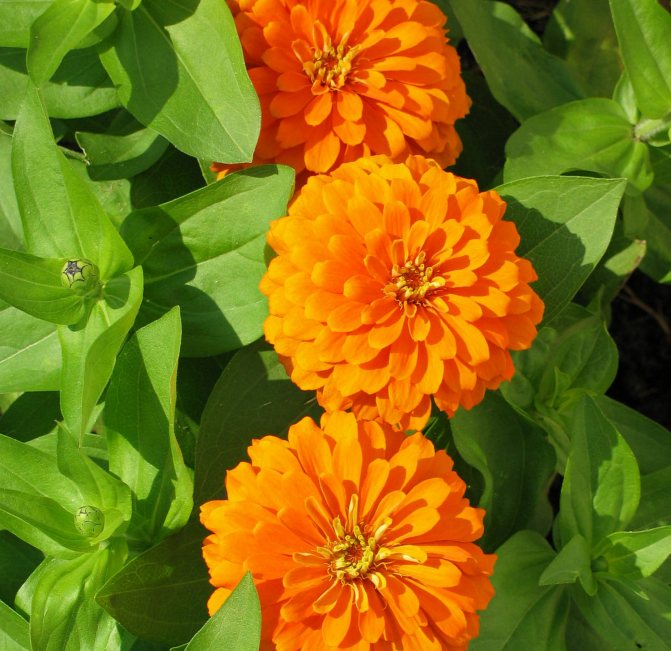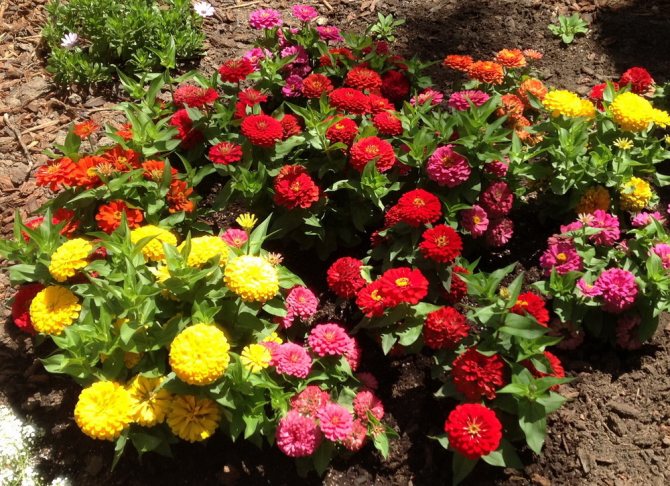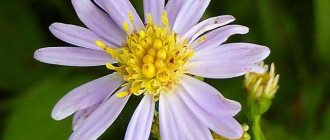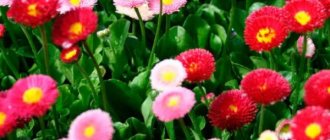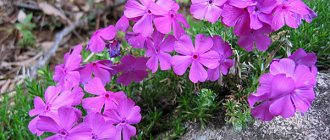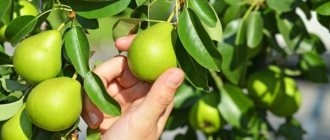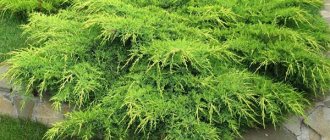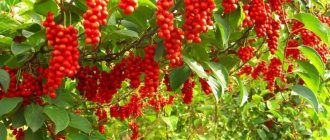Home »Flowers and plants» Flowers »Annual flowers
Annual flowers
Olga Polyakova
1 comment

Zinnia is a plant from the Astrov family. All species of the genus Zinnia are native to the Western Hemisphere. The genus includes about twenty species of grasses, shrubs and dwarf shrubs. Most of its representatives in their homeland plants are perennials. In the temperate climates of the Eastern Hemisphere, they are grown as annuals.
- Biological description
- Growing conditions
- Planting a plant in a seedling way
- Planting plants in open ground
- Plant care
- Diseases
- Varieties
- Zinnia graceful
- Zinnia Barpis
- Carousel
- Persian rug
- polar bear
- Violet
- Orange king
- Narrow-leaved
- Fine color or linearis
Seed collection
In order to collect the seeds, you just need to choose the most beautiful inflorescences in your flower garden and wait until they ripen and dry. After that, you can cut off the box. The plant will take about 2 months to fully mature, so it is better to leave the very first flowers in advance. They most often grow large and lush.
Cut baskets can be dried additionally in a dry room. Then you need to carefully pull out the petals and get the seeds. After that, they are sorted out, dried again on the newspaper and laid out in paper envelopes.
Sowing in open ground
Majorchikas are sown in the flower garden when the last frosts have passed. I plant myself in April, focusing on the end of apricot flowering. (In our region, every year a joke of nature: as soon as apricots bloom, frosts are bound to happen). I always prepare the soil in advance, since autumn, at the same time as the garden. I dig the site well, about the bayonet of a shovel, if necessary, add lime, remove plant residues. In the spring, I additionally loosen with the simultaneous introduction of superphosphate.
Read our related article: Preparing the beds in the spring. List of required activities
Expert opinion
Mikheeva Tamara Gennadievna
Dedicates most of his time to flower beds in his garden and landscaping
Ask a Question
N.I. Kurdyumov, in his books on natural agriculture, recommends replacing the shovel with a Fokin flat cutter. The tool is convenient, allows you to perform about twenty gardening operations, facilitates the work of the summer resident, sparingly affects the soil.
I sow seeds in grooves to a depth of 2-3 cm. I do not soak them in advance, but sprinkle them dry. Sprinkle with earth on top and water it a little from a watering can. After 7-10 days, the first shoots appear, and after another week you can thin them out. This sowing method is more suitable for southern regions, where the land warms up quite early, and the flowers have time to go through the full growing season. Many summer residents prefer to germinate seeds in advance, and then plant them according to the planned scheme without further thinning.
How to select quality seeds
Large seeds germinate most quickly, the first shoots may appear already on the 3rd day. But often both semi-double and non-double inflorescences can grow from one package. Even if the seed is harvested only from terry inflorescences, there is still a risk that a large number of grown flowers will be simple or semi-double.
The only option is to select quality material for sowing. Simple flowers grow from dark brown heart-shaped seeds. It is better to get rid of such people. Leave only elongated, spear-like seeds with a pointed triangular tip. They usually have a grayish tint. Of course, such a selection does not guarantee that absolutely all inflorescences will be terry, but there will be much more of them. In addition, large and high-quality seeds have a higher germination capacity. Immediately after you take the seeds out of the flower, you can sort them out, and leave in this form for storage. Then in the spring there will be less worries with sowing.


Zinnia wintering
In our country, zinnia is grown as an annual, which means that seeds are collected in the fall for the next season. Potted forms of culture with a cold snap are brought into the house or a heated greenhouse, where they take care of it like a houseplant.
Zinnia is a strict, aristocratic plant. It looks great in mono compositions and is no less beautiful in joint compositions with phlox, chrysanthemum, marigold and other flowers. The gardener only needs to plant the culture, she will do the rest herself.
When the seeds are harvested
The seed can be considered mature as early as 60 days after the start of flowering. Therefore, it is advisable to leave the first emerging flowers for these purposes. But even among them, you should choose only the largest and most lush. Then they will need to be dried and only suitable seeds selected. Store them in a cool dry place. It is very important that in winter it is not affected by cold and moisture, otherwise they will simply damp. Under suitable conditions, they can be stored for 3 or 4 years without losing their sowing qualities.
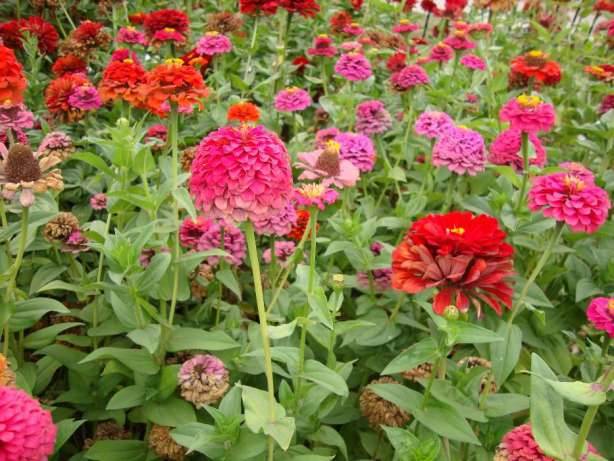

If you are growing multiple varieties, then these seeds should be stored in separate boxes or envelopes. Do not forget to sign each bag so that you do not get confused when planting. Also indicate on the packaging the year the material was collected. Some gardeners who like to arrange their flower beds in an original way also indicate the color of zinnia. Then they plant the plants in rows or circles.
If the room temperature was not suitable or the seeds were stored in a plastic bag, germination may decrease. The shelf life will also be reduced. It will be better to sow such material next year, since in the future they may not sprout.
What flowers to collect
Zinnia seeds are harvested from flowers of the correct shape and bright colors. During flowering, specimens of zinnia flowers are immediately selected, which are especially pleasing to the eyes. To recognize the necessary flowers when they dry up, the heads are marked with bright strings during flowering.


Seed material is taken only from plants with a thick stem and a well-developed head. You should not collect seed from low-growing plants, in which case the seed will be of poor quality.
What do zinnia seeds look like?
Bright Zinnia is a favorite of flower growers.
Perennial zinnia is an excellent choice for decorating any area. There are many reasons for this. First of all, it is impossible to remain indifferent when looking at large double and non-double inflorescences-baskets of all kinds of the brightest colors. Secondly, gardeners are attracted by the long flowering period. Zinnia begins to bloom in July and blooms until late autumn, until frost hits. The third reason gardeners choose to grow zinnia on their property is its drought tolerance. Rather, on the contrary, it can die with excessive watering, but it perfectly withstands the driest summer. So let's take a look at some of the features of breeding and caring for this striking member of the Compositae family.
Favorable conditions for growth
Among all cultivated zinnias, simple and semi-double types are the most unpretentious.They adapt perfectly to hostile environments. The main thing is that there is no waterlogging of the soil, otherwise the plants will get sick. I had to plant the majors after the construction of the house, when the ground in the flower garden was terrible - stony, with fragments of building materials. Despite all this, the plantings bloomed quite luxuriantly.
To get the most out of your crop, you need to create a number of conditions for good growth. Zinnia loves light and warmth, so it is planted in well-lit, open areas. At the same time, they provide protection from northern winds, since cold, especially light frosts, are undesirable for the plant. The soil is needed loose, moderately fertile, with acidity closer to neutral. Zinnia, although drought tolerant, needs good watering from time to time.
How and when to plant zinnia
Despite the fact that perennial zinnia is a fairly hardy plant, there are several features that you need to pay attention to. After all, only if all the necessary conditions are met, this beauty, who came from distant America, will delight you with rich flowering.
Choosing a landing site... A sunny location that is protected from the wind is ideal. For example, it can be a small lowland with gentle slopes. The selected place for zinnia must be dug up and, if necessary, organic fertilizers must be applied.
Pay attention to the soil... It should be neutral or slightly acidic, fertile and sufficiently moist. Especially you have to worry about good drainage. This is very important, because at the slightest stagnation of moisture, the plant begins to rot and can die in a matter of days. Zinnia seeds are planted in early spring in fertile soil. Covering the container with a dark film can accelerate the emergence of seedlings. As soon as the seedlings have appeared, the film is removed, and the box with the seedlings is placed on the windowsill. Plants dive after the appearance of the second leaf. The time of planting in the ground is determined by the only factor - the possibility of frost. Experts recommend not even trying to plant zinnia in open ground before the heat is established and there will be no frost. Otherwise, all landings will die. Seedlings are planted at a distance of 15 to 30 cm from each other. It all depends on the variety of zinnia. If you decide to grow your zinnia directly from seed, not seedlings, be sure to germinate them in a damp cloth. After a week or so, the seeds will hatch. All this time, you will have to make sure that the fabric does not dry out. But a napkin that is too wet will not work. In this case, the seeds will simply rot. The last condition for successful germination will be temperature. It should be 20˚С, not higher or lower. If the plantings of zinnia turned out to be thickened, it is better to plant the plants. To transplant zinnia, it is advisable to transfer it to a new place so that there is a sufficiently large clod of earth on the roots.
Varieties
Zinnia species diversity is relatively small... There are about two dozen species, of which only 4 are widely used in landscape design. It was on their basis that the currently existing varietal subspecies and hybrids were created.
back to menu ↑
See also: Princess Nasturtium: a familiar stranger. Description, types, growing from seeds, care (50 Photos & Videos) + Reviews
Zinnia graceful
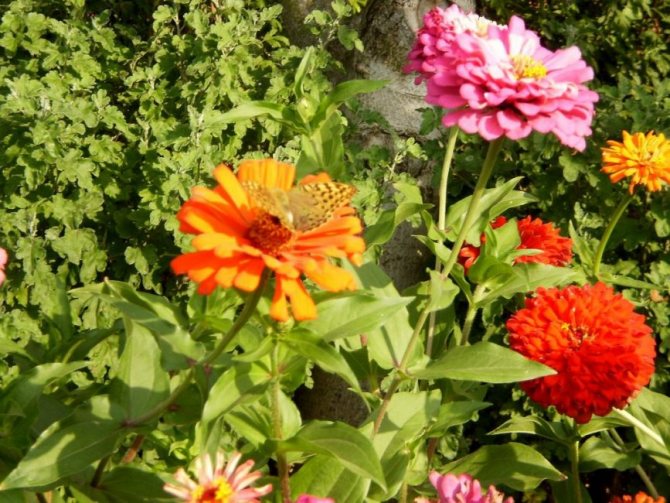

Zinnia graceful
It is the nomenclature type of zinnia and is the most widespread. In another way, this type is also called "elegant zinnia". Botanists in England and Ireland officially call it "youth-and-old age", most likely similar to coltsfoot, due to the varying degrees of pubescence of the leaves.
The plant is a typical representative of the Asteraceae, originating from Mexico. The flower is an annual, even in its homeland.Depending on the variety, it has a height of 30 to 130 cm. The stems are mostly not branched. They have a round cross-section and are covered with a small edging.
Leaves The plant has an elongated ovoid shape, slightly pointed at the tips. The size of the leaves is 5-7 cm in length and 3-4 in width. The leaves are slightly pubescent, different on the upper and lower parts of the leaf.
Flowers Plants are collected in basket inflorescences. They are quite large - from 5 to 16 cm in diameter. Moreover, depending on the variety and growing conditions, flower petals can be either simple or double. It is believed that with a prolonged stay without moisture, the terry of the petals disappears.
Bloom Plants occur in the second half of summer, but can last from late July to the very frost. The first ripe zinnia seeds appear about 8-10 weeks after the start of flowering.
The plant has relatively large seeds, their size is 10-15 mm in length and about 6 mm in width. Moreover, the seeds are always flattened. Their shape can be very diverse - from narrow and long to oval and round. One gram contains about 150 seeds. Germination rate above 85% is maintained for the first two years, then it drops somewhat. It is best to plant seeds within the first year after harvesting.
Often, designers are faced with the fact that seeds can germinate unevenly.... Therefore, the appearance of a plot with zinnias may be slightly spoiled by less beautiful and undersized specimens. To avoid such troubles, it is recommended to choose seeds for flower carpets from the apical basket of the central zinnia shoot. It is believed that the seeds from this particular shoot have the highest germination capacity.
The plant does not naturally cross with other types of zinnias, however, there are ways to do this indirectly. Thanks to this, many varieties of this plant were obtained.
Zinnia graceful contains three groups of varietal varieties, united by common characteristics:
- dahlia group
- pom-pom group
- group "fantasy"
1


Dahlia zinnia
Zinnia dahlia represents large bushes, about 1 m high, with large leaves about 12-15 cm long. It is distinguished by large spherical inflorescences, about 15 cm in diameter. The inflorescences contain many double petals. The shape of the flower and its colors are very diverse.
For normal growth, this species requires not only a well-lit area and regular watering, but also top dressing. They are applied in the form of organic fertilizers in the fall, as well as in the form of mineral fertilizers just before the beginning of flowering.
Most varieties of dahlia zinnia are inhabitants of a warm climate. In temperate climates, only a few varieties thrive in outdoor conditions.
2
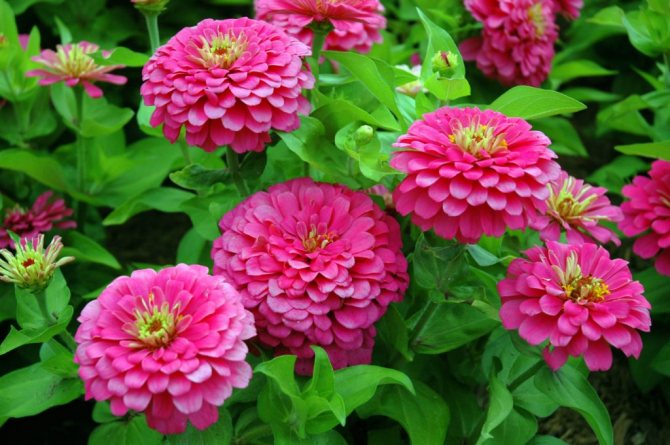

Pompom group consists of low plants, no more than 50 cm high. They have dense and compact bushes with a large number of stems. The size of the flowers is small - about 4 cm, the flowering of the plant begins in all flowers almost simultaneously.
3
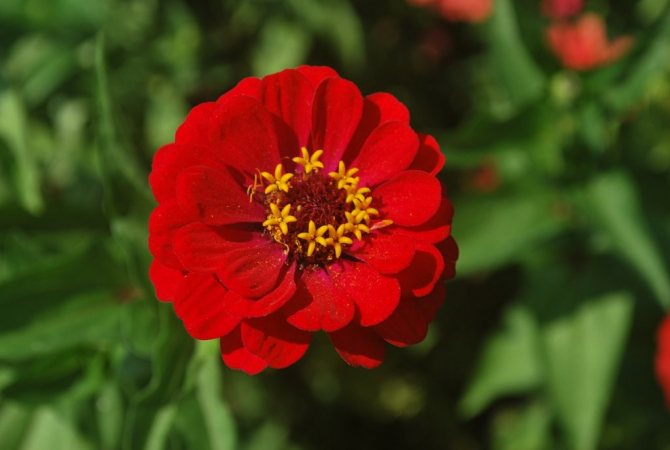

Representatives of the Fantasy group
Group Fantasy consists of plants of medium height (up to 70 cm) with relatively large leaves and flowers. The diameter of the flowers is about 10 cm. The shape of the structure of the flowers of the Fantasy resembles a dahlia. The difference lies in the fact that its flowers are able to bloom as much as possible, bending in different directions. Sometimes they differ in non-standard colors or a special shape of the leaves.
Consider the most popular zinnia varieties that can be grown in our climate outdoors:
back to menu ↑
See also: Anemones: 25 species, features of reproduction and care, planting in open ground, forcing in winter, a description of the medicinal properties of the plant (50+ Photos & Videos) + Reviews
Zinnia Barpis
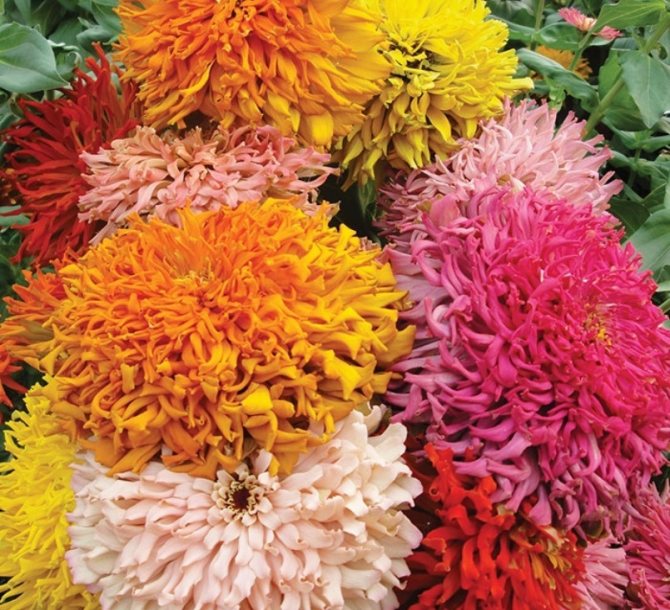

Zinnia Barpis It is a terry variety with various shades of petals. The plant is very decorative. Its flowers are up to 13 cm in diameter, they have a flattened spherical shape. The plant is distinguished by long flowering, as well as good durability when cut. If, after cutting, you put the flowers in hot water, they can stand in it with almost no loss of appearance for about 3 weeks.
The plant has long and strong stems that do not require a garter. The bushes are best planted in well-lit areas, because with a lack of light, the stems can stretch significantly, and the size of the flower will be small.
The variety is thermophilic, in order to avoid frosts when caring for it, it begins to grow in early March in the form of seedlings. Flowering with this method of cultivation begins in June.
back to menu ↑
See also: How to create beautiful flower beds and flower beds in the country with your own hands? (220 fresh photos and video ideas) + Reviews
Carousel
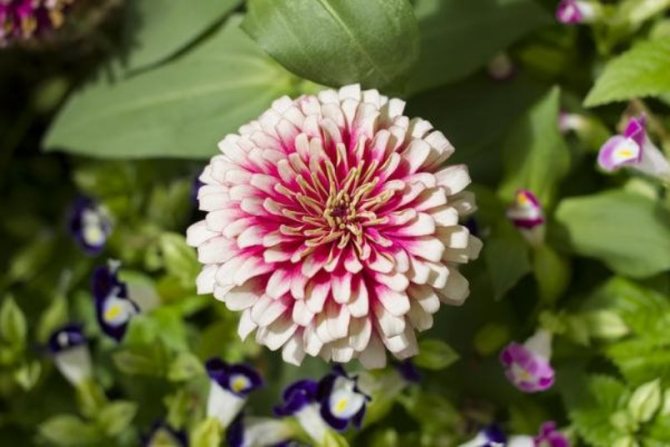

Carousel An annual with petals of two (sometimes three) colors. The inner part of the petals, attached to the calyx, has a color that matches the color of the stamens, while the outer color may differ significantly. In some cases, a gradient coloring of the petal with a smooth transition from one color to another is possible.
The diameter of the flowers of the Carousel reaches 12 cm, and the height of their stems rarely exceeds 50 cm. Inflorescences are usually double. Flowering begins in the first decade of July, provided that the plant is grown with seedlings and planted in mid-March. When planted in open ground in May, flowering occurs in mid-August. Flowering can be extended by removing faded inflorescences.
He loves soils fertilized with rotted manure or mullein in the fall. This variety is calcephilous (that is, it prefers weakly or moderately alkaline soils), which is a rare case in the floriculture of our latitudes. Does not tolerate shade and strong wind. The ideal landing site is the well-protected southern slope of the site.
back to menu ↑
See also: Perennial asters: description of 13 species, care and planting at home, methods of reproduction and growing from seeds + Reviews
Persian rug
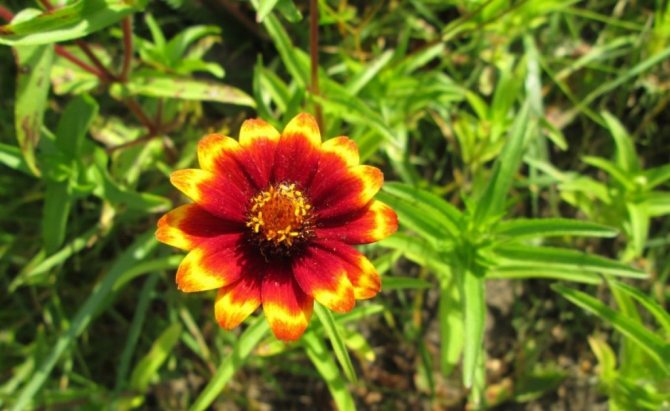

Persian rug A colorful tricolor plant, about 45 cm high with yellow, orange and red flowers. The leaves of the plant are triangular in shape, light green in color. The diameter of the flowers is 5-6 cm.
In flower beds, it goes well with marigolds or calendula, despite the similarity in colors. The bushes of the plant are quite dense and compact. The recommended distance for planting in open ground is 30-40 cm.
It is grown using a seedling method, while the rate of bush formation is one of the highest among zinnias. The plant is able to bloom within a month after the seeds have hatched. In warm areas, landing directly into open ground is permissible as early as April.
Flowering lasts, depending on planting time, from May to October. This variety does not tolerate waterlogging well, so watering should be scarce rather than moderate.
back to menu ↑
See also: Weigela: description, types and varieties, planting in open ground and proper care of the plant (60 Photos & Videos) + Reviews
polar bear
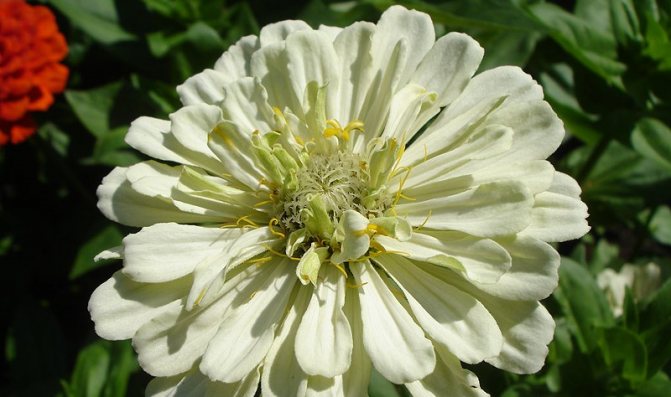

polar bear The height of the bush is about 60 cm. This variety loves a lot of light and warmth. In addition, the plant responds well to feeding during the flowering period. They must be done about once every 3-4 weeks.
Flowering is observed from mid-June to late August. Using a standard technique with the removal of faded inflorescences, it can be extended by 1-2 months.
back to menu ↑
See also: Currant: description, planting in open ground, care in spring, summer and autumn, reproduction, popular varieties (23 Photos & Video) + Reviews
Violet
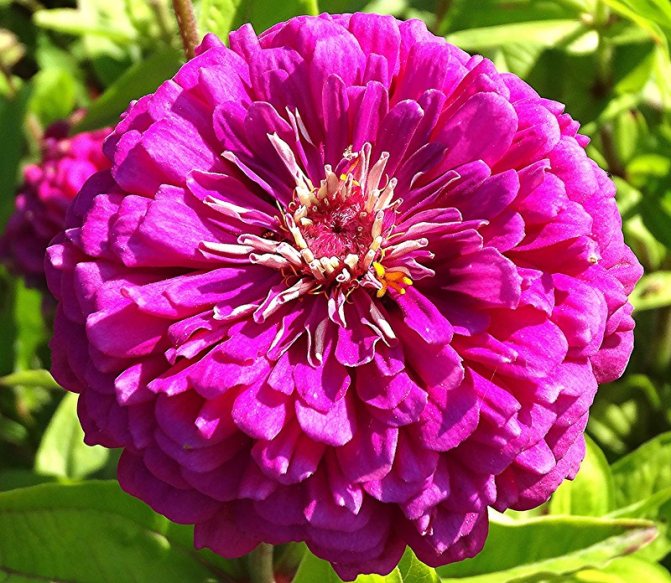

Violet The name of the variety speaks of its shades. It is predominantly purple, but there are shades of purple and blue.It has dense double inflorescences, of which there can be more than 20 on the bush. The buds are rather large - from 10 to 12 cm. The flowering time is about three months, it begins in June.
The height of the stems of this variety of zinnia reaches 90 cm. Prefers loose soils of neutral acidity; unlike some varieties of this species and graceful zinnia, it does not like loams, but grows well on sandy soils.
back to menu ↑
See also: Marigolds (Chernobrivtsy) are one of the best annuals. Description, growing from seeds, planting and care, possible diseases (80+ Photos & Videos) + Reviews
Orange king
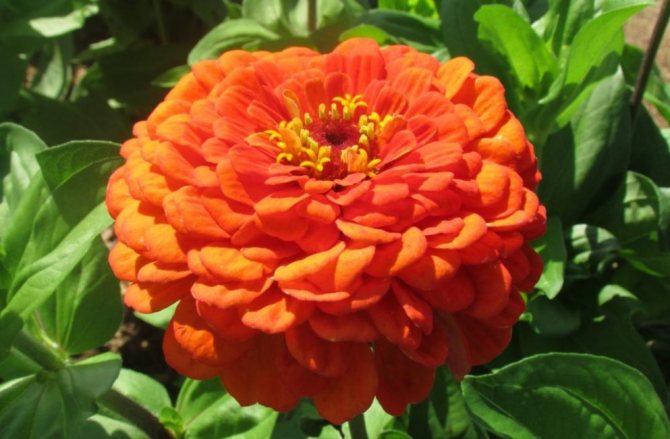

Orange king It is the same Violet, however, a little more compact and has an orange color. On bushes 65-70 cm high there are large double flowers up to 14 cm in diameter. Growing conditions and flowering features are similar to the Violet variety.
back to menu ↑
See also: Gazebos with barbecue and barbecue - (80+ PHOTOS) Drawings of projects that you can implement yourself
Narrow-leaved
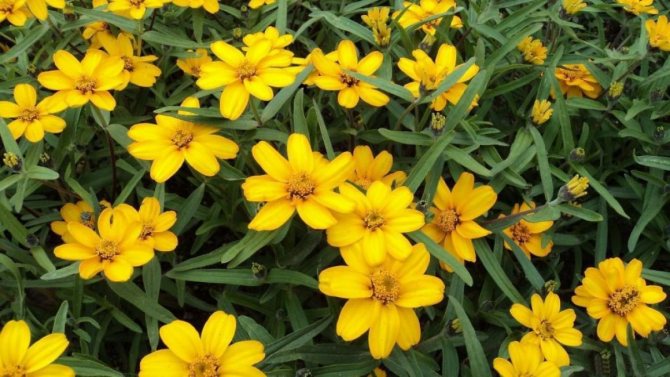

Zinnia angustifolia This species is characterized by elongated leaves with pointed ends. The height of representatives of this species reaches 60-70 cm, they have medium-sized flowers with a diameter of 4-6 cm. For narrow-leaved zinnias, a relatively small number of petals in a flower is characteristic.
back to menu ↑
See also: Campsis: description, types, planting in the open field, reproduction and care of a beautiful liana (85+ Photos & Videos) + Reviews
Fine color or linearis


Zinnia fine-colored and zinnia linearis
Zinnia fine-colored and zinnia linearis Representatives of these two species are thermophilic plants and in our climate, their cultivation is possible only at home. The height of these plants ranges from 30 to 60 cm, most of them have small flowers, about 3 cm in diameter.
Zinnias are used in landscape design primarily in group plantings. They look good in mixborders and borders. Plants go well with asters, marigolds, calendula and chrysanthemums. Zinnias will also find their place in individual planting, since their compact and neat bushes look beautiful on their own.
These flowers can be used not only in flower beds and flower beds, but also in vegetable gardens - as separators for beds or plants that perform functions of attracting attention. The popularity of this plant is increasing every year and they are increasingly replacing crops already familiar to everyone, such as asters, nasturtiums and marigolds.
See also: What to plant under the trees: flowers, plants or vegetables? In the garden or garden in the shade (40+ Photos & Videos) + Reviews
We take care of the flower garden from Zinnia
Finally, the zinnias are safely planted in the chosen area. How to care for them during the summer? The whole range of care measures is in three words: watering, loosening, feeding.
- Let's start with watering. Despite the fact that zinnia belongs to drought-resistant plants, in the absence of watering, it loses all its decorative effect. Watering zinnia is necessary rarely, but abundantly.
- After planting seedlings in open ground, zinnia should be fed 1 time with liquid manure. Remember to fertilize before flowering.
- The land in a flowerbed with zinnias must be loosened after each watering.
Zinnia flowers can stand in a vase for quite some time. The bouquet will not fade for about two weeks. Moreover, these flowers are completely odorless. This means that a bouquet of them will not give anyone unpleasant sensations in the form of a headache. So grow your zinnia and enjoy the riot of color it is sure to provide.
Diseases
One of the plant's main problems is its vulnerability to powdery mildew. This disease is quite easy to recognize: with it, the leaves and stems of the plant are covered with a kind of gray coating.The reasons for its appearance can be very different: violation of the conditions for caring for the plant, insect attacks, excessive watering, etc. Plants in humid conditions are especially vulnerable to this disease. Most often, powdery mildew affects plants during periods of cold and rainy summers.


Zinnia leaves affected by disease
The disease can be defeated with modern fungicides. The main thing is to prevent its repeated manifestations in the future. To do this, it is necessary to change the conditions of the plant and adjust the watering.
In addition, the plant can sometimes be affected by fusarium and root rot. As a rule, the main causes of such diseases are associated with the same as powdery mildew - high humidity. Adjusting the watering regime and regularly loosening the soil after watering are the best preventive measures against such diseases.
back to menu ↑
See also: TOP-35 Most unusual and amazing plants in the world | + Reviews
The most beautiful species and varieties with photos
There are many types of crops in nature, from which a large number of varieties with unique characteristics later emerged.
All varieties can be divided into three groups depending on the size of the plant:
- Tall. The length of the shoots is 60–90 cm, they are grown for bouquets, in flower beds such giants look cumbersome.
- Medium-sized. Peduncles stretch 35–55 cm. They serve as a decoration for city garden beds.
- Stunted. Stems 15–30 cm long. Suitable for home flowerpots and flower beds.
Graceful
Annual, one of the most popular species. Tall, the shoots stretch up to 90 cm, the stem is stable, easily tolerates adverse weather factors.
The existing varieties of zinnia graceful are divided into groups:
- dahlia - massive inflorescences, tall bushes;
- chrysanthemum flowers - stem 40–80 cm, massive baskets, up to 16 cm in diameter;
- pompon - branched, with abundant and long (up to a month) flowering, frost-resistant;
- fantazi - compact spherical shape, shoots up to 65 cm, loose flowers with shaggy petals.
The most popular varieties:
- Violet. Sprawling, the height of the shoots is 75 cm. The inflorescences are dense, velvety, the color of the buds is purple.
- Lavender Queen. Branched bush, reaches 80 cm in height. The inflorescences are collected densely, massive, up to 12 cm in diameter. Lavender-type flower, purple color.
- Little Red Riding Hood. A shrub with increased doubleness, with age it takes the shape of a ball. It stretches up to half a meter in height, the inflorescences are velvety, dense, with a diameter of 4 cm. The flowers are deep red, do not fade even in direct sunlight.
- Tom Tamb. Low (up to 45 cm) compact shrub. The inflorescences are dense, covered with pile, about 5 cm across. The color of the petals is deep red, does not fade in the sun.
Narrow-leaved
Powerful shrub with straight stems. Forms many shoots up to 40 cm high. The leaves are classic, grow up to 6 cm, expand towards the base. Inflorescences are miniature, up to 4 cm in diameter, monochromatic. The color is often rich orange, some varieties have reddish specks at the tips of the petals.
Seeds of narrow-leaved zinnia, remain viable for 4 years.
The Sunny Circle variety is especially popular due to its long, abundant flowering. The bush is smaller in height (up to 25 cm), the inflorescences are velvety, about 3.5 cm in diameter. The buds are dark orange towards the base, red at the ends.
Subtle
Tall (up to 60 cm) view. Shoots are thin, geniculate, light red. Inflorescences 3 cm in diameter, reed-type flowers, slightly curved tips. The color is purple. In horticulture, the Red Spider variety is common.
Linearis
It looks like narrow-leaved zinnia - both types have pointed and narrow foliage. Cultivated more often than others. The bushes are compact, grow up to 35 cm, taking the shape of a ball. Inflorescences with yellow petals and orange outline.
The most common varieties:
- Golden ai - white flowers, tubular core, shape reminiscent of chamomile;
- Caramel - the core is black, the petals are caramel-yellow.
- Yellow Star - yellow flowers.


Graceful
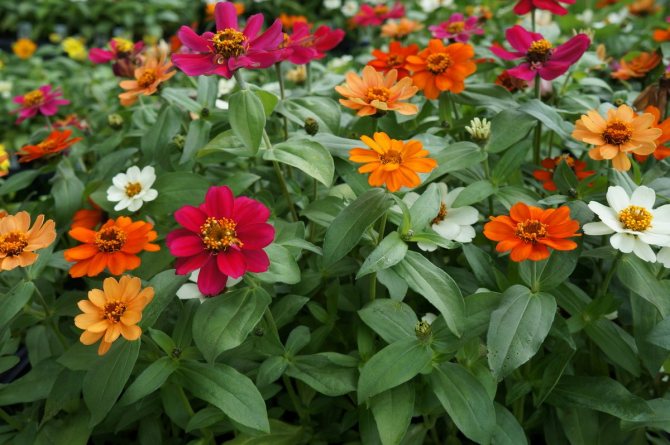

Narrow-leaved
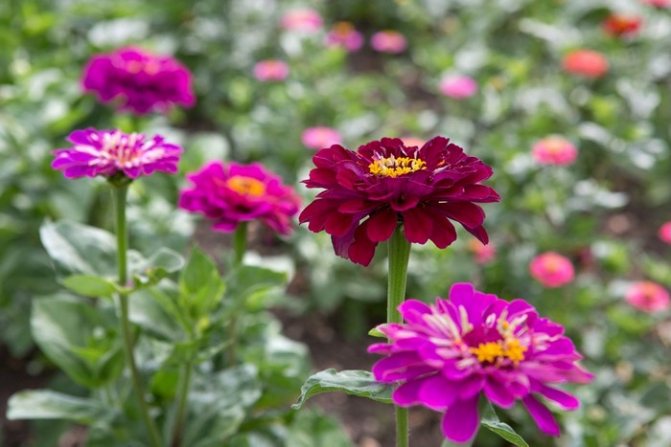

Subtle
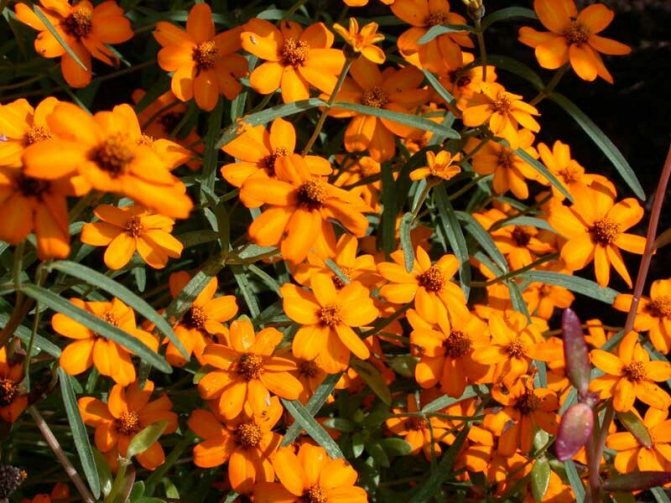

Linearis
Treatment of diseases
Zinnia is susceptible to diseases such as:
- Spotting is a fairly serious disease that is incurable. At the first signs of damage, the damaged areas of the plant should be removed immediately. If the bush is completely damaged, it is dug up and destroyed.
- Powdery mildew is the most common disease in zinnia. The main symptom is white spots on the leaves and stem. It is treated with fungicides, for example, Topaz.
- Gray rot is another disease that can be treated with one of the fungicides. In this case, Fundazol is most often used.
Boarding time
To correctly determine the time when to plant zinnias in open ground, they are guided by the weather conditions. If the nights are cold, and there are frosts on the soil, it is worthwhile to wait. If the soil warms up well and the temperature does not drop below zero, flowers can be planted. Depending on the planting method, the most suitable month is chosen. For example, the end of April is chosen for planting seeds in open ground. If ready-made seedlings are planted in the ground, they choose a fine day in mid-May.
How to plant zinnias with seeds in the ground
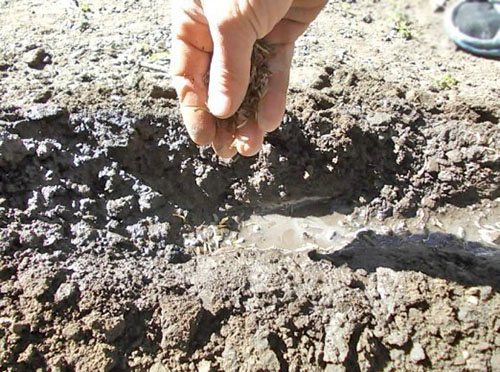

The method of planting zinnia in the ground with seeds is more suitable for the southern regions of Russia. The climatic conditions of the regions contribute to the rapid heating of the soil. In order for the seeds to give strong shoots on time, flower growers use the following planting algorithm:
- the seeds are wrapped 5 days before planting in a warm cloth soaked in an epin solution for germination;
- choose a well-lit place for the flower bed;
- prepare the soil - loosen it, apply fertilizers (superphosphate) and sand to improve drainage properties;
- determine the planting scheme, most often the seeds are sown in a curly way (in the form of a circle, heart, chamomile);
- on the day of planting, all weeds and stones are removed from the flower bed;
- grooves are made in the ground and the hatched seeds are planted.
The groove for the majors should be made 4 cm deep, and the seeds should be placed at a distance of 30 cm from each other. Majors grow in this case larger and more bushy. If the seeds are placed too close in a row, the flowers will be smaller and weaker.
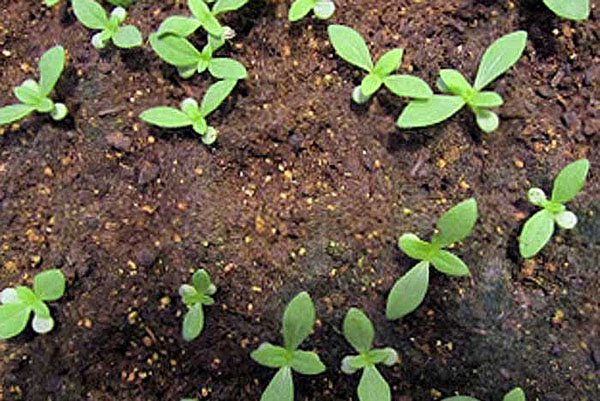

Prepared seeds germinate well. If they are not germinated in advance, half of the planting material may not germinate. After planting, the flower bed is watered through a spray bottle so as not to clog the soil. The next watering is done after the sprouts appear.
Planting zinnia seedlings
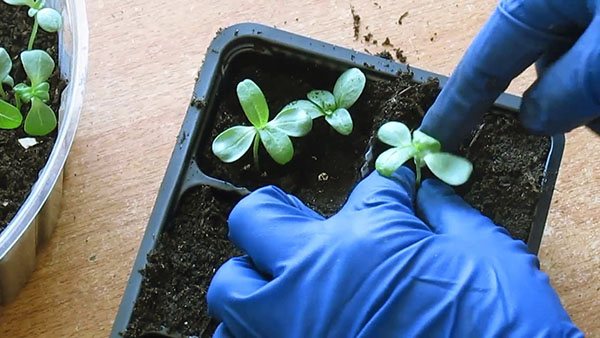

The second way is to plant zinnia in the ground in spring with seedlings. This method is suitable for any region, as it gives a guaranteed result. Seedlings are grown in advance and planted when a good temperature regime is established. The algorithm of actions in this case is the same as when planting seeds. The difference is that the seedlings are placed at a distance of 35 - 40 cm from each other, deepening by 5 - 6 cm. After planting, the seedlings are well watered.
When replanting young plants to a flower bed, you must not damage the roots and shoots. If the plant was in a peat pot, then it does not need to be removed - it is better to plant it directly in the pot.
When the planting of zinnia in open ground is completed, the flowers are cared for - watered abundantly, weeds are removed and fertilized.
Diseases and pests on flowers
Cynia can be affected by gray mold, alternaria, sclerotinia, powdery mildew. These diseases can not only worsen the appearance of the crop, but also reduce the number of flower stalks produced by zinnia and completely destroy the plant. So you need to deal with them when the first signs of an illness appear. Specialized fungicides such as Tattu, Quadris, Bravo, Acrobat, Previkur Energy are used for treatment.
Of the pests, the most problems arise with scoops, aphids, snails, midges of various types.What to do with them if they appear? For a start, you can treat it with soapy water or sprinkle with wood ash, but these traditional methods help to cope with only a small number of insects. If a large colony has settled on the flowers, insecticides Aktara, Actellik, Karbofos, Decis, Prestige and the like can be used to combat. With timely introduction, the plant can be saved, and it will bloom in time, delighting gardeners with its amazing flowers.
Flower care
Beautiful flowers, rich foliage, zinnias are given in the event that they are provided with full care.
- The majors cannot stand drought. After planting in a flower bed, they must be watered in a timely manner so that they do not dry out. In dry seasons, water is added more often, and less often during rains.
- It is advisable to do weeding regularly - after watering, rains, so that the earth is not taken with a dense crust.
- Weeds next to these flowers are uprooted.
Interesting!
Zinnia looks best in large flower arrangements. Therefore, it is recommended to make seedlings in large quantities so that they do not grow as a single flower.
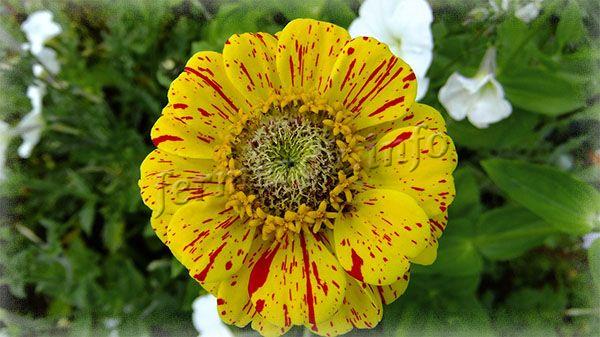

Photo of Tsiniya linearis Caramel
- After planting, after 2 weeks, you can begin to fertilize the culture. Experts recommend applying liquid fertilizers for flower beds, flower plants every 14 days, but you can do it a little less often.
- To make the plants sick less often, the weeds do not grow, many gardeners carry out mulching of the plantings.
- All dry leaves, faded inflorescences must be cut off.
Proper care and timely feeding allow you to get more beautiful, vibrant flowers from the plant.
Origin
Zinnia naturally grows in the countries of South America. And these beautiful flowering plants came to the European continent at the end of the 18th century. And in the last century, these beautiful representatives of the Astrov family began to be actively used for landscaping and decorating city parks and squares, as well as planting them in garden plots.


Homeland of zinnia
But zinnias became truly famous after zinnia became the first flowering plant in space conditions on a space station.
Pest control
Zinnia, like other cultivated plants, is susceptible to the invasion of various pests. Who can attack this flower and how to get rid of the parasites?
- Snails and slugs - in order to remove them from the flower bed, you can spread small pieces of roofing material under the bushes. In search of moisture, they will crawl under the roofing material, after which this material will only have to be taken out of the site.
- May beetles - they appear at the end of spring and, in large concentrations, can severely damage young plants. These pests are usually picked by hand.
- Aphids. With aphids, if there are few of them, a solution of tar soap works perfectly. But when the colony of parasites grows strongly, then in this case it is necessary to use more powerful drugs, for example, "Fufanon".
Planting Zinnia
Can be grown both with seedlings and directly plant seeds in open ground.
Landing in the open field
To make it easier for themselves, many growers sow Zinnia seeds directly into open ground.
You can plant seeds in open ground, bypassing the seedling procedure
When to plant
Seeds can be planted in early or late May, depending on the region and weather conditions. In warm sunny weather, the seeds germinate within a week, and if the crops are covered with lutrasil, this will increase the germination and germination rate of seeds.
With this sowing of seeds, seedlings hardening will not be needed when transplanting it to a permanent place.
Seed planting process
The garden bed prepared in the fall is once again dug up and well leveled. Zinnia seeds are sown in 5 cm increments. 10 cm are left between the rows. Everything is sprinkled on top with purchased soil, it is quite loose and nutritious, which will stimulate good seedling growth.
Water the crops carefully so as not to wash the seeds out of the soil and cover them with a film for better seed germination. On hot days, you will need to ventilate such a greenhouse so that the young seedlings do not get rid of the greenhouse conditions.
When 2-3 true leaves appear on the seedlings, it are seated in permanent places habitat, choosing sunny places in the flower bed.
For seedlings, it is important not to wash the seeds when watering
Basic requirements for outdoor care
In order for the seedlings to grow well and do not lack anything, appropriate care is needed for it.
Watering - should be carried out in the morning or evening hours every day with not a lot of warm water. Watering during the day in sunny weather will likely burn the young foliage of the seedlings.
When watering, try do not fall on sheet plates, as brown spots of leaf burn may appear under the film on wet places.
The temperature for good growth of seedlings should be at least 18-20 degrees Celsius. If the temperature is within these limits during the day, and drops at night, then a temporary shelter for the seedlings will be required for the night.
Zinnia does not tolerate sub-zero temperatures and completely blackens and dies.
If nitrogen fertilization was carried out during the preparation of the soil in the fall, then no more fertilization in spring... If the seeds are planted in unprepared soil, then when seedlings appear, fertilizing the seedlings with full mineral fertilizer will be required.
How and why to pinch, dive Zinnia
Seedlings should be pinched over the 6th leaf, if it will serve as a flower bed decoration. With this pruning, bushiness increases and there will be much more flowers. If grown on a cut, then pinching is not worth it.
Zinnia seedlings dive and seat in separate 200 gr. cups to increase the feeding area of each individual sprout.
When diving, deepen the seedling 3 cm.
Diseases and pests
Sometimes, with improper care of Zinnias or due to unfavorable weather, the pet starts to get sick or is attacked by harmful insects.
If in wet weather amazes aphidto get rid of it, it is worth treating the flowers with Actellik's solution.
Snails and slugsthat eat Zinnia leaves during or after the rains are harvested by hand.
Most often, the plant can be seen powdery mildewthat appears during rainy summers.
Such diseases also appear:
It is sometimes necessary to inspect flowers in order to identify diseased specimens in time.
After flowering
The seed boxes ripen a couple of months after flowering. Therefore, in order to collect their own seeds, they choose the buds they like, mark the plant and remove all side shoots.
When the seed pod turns light brown, it is cut off, dried, taking out seeds and storing them in paper bags.
It will not be superfluous to sign the year of seed collection so the seeds retain their germination capacity for up to 4 years.
Features of winter care
The peculiarities are to remove the stem of the plant that is blackened from frost from the flower bed and prepare the flower bed for the next warm season.
How to plant from seed for seedlings
It is a real pleasure for the gardener to work with planting seeds of this type. Zinnia's seeds are large and have easy germination.
You can also make up the soil for seedlings yourself by taking:
The seeds are laid out at a distance of 5 cm from each other, if you plant them closer, then after a while you will need to pick the seedlings.
Before planting the seeds, soak them according to the instructions in Epin's solution.
Also for friendly seed germination cover the container with glass... And then, three weeks later, friendly shoots will appear, after which the glass is removed. Further care of the seedlings consists of:
- Watering.
- Loosening.
- Providing lots of sunshine.
Zinnia flower through the eyes of a botanist
The name of the German physician and botanist Johann Zinn, who in the distant 18th century was the first to bring seeds of a flower unknown to Europeans, was forever fixed in the name of the flower. From that moment on, it became firmly rooted in European flower gardens.
The plant loves warmth, open sunny places, does not require special care and is not capricious. It is distinguished by its ability to grow rapidly and bloom for a long time. The flowers outwardly resemble dahlias, marigolds and chrysanthemums.
The use of zinnias in garden design
They are used in flower beds, ridges, groups, large tracts and for cutting. Tall varieties are ideal for decorating flower beds and beds. For balconies and containers, medium-sized and undersized (15-20 cm) varieties are suitable. They are resistant to wind and bloom profusely and continuously. Zinnias look especially good as a group.
Flowers stand well in water and retain their color brightness for a long time. They are cut when the inflorescence is 3/4 open, the ends of the stems are fired or cut in hot water. A withered bouquet of zinnias can be restored to freshness by placing it in hot water and first updating the lower oblique cut.
Zinnias of low-growing varieties can be dug up with a lump of earth before frosts, planted in large pots, watered abundantly and kept in a room on a light window. Then they will decorate your apartment for several more weeks.
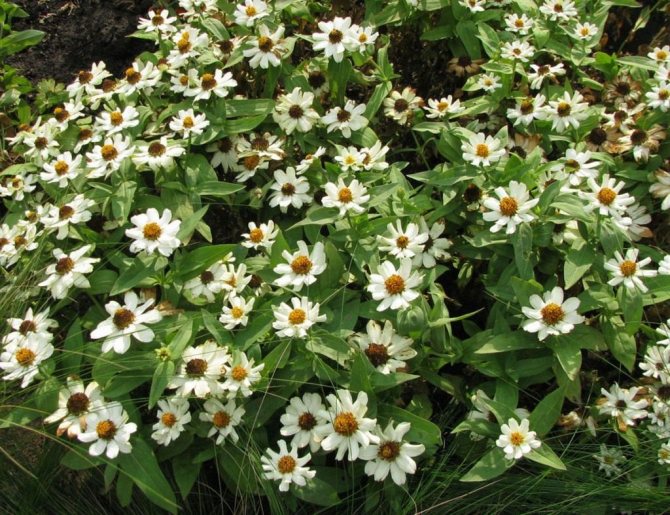

Zinnia is narrow-leaved.
Growing cyclamen from seeds at home
Cyclamens are indoor flowering plants that can be easily grown on their own at home from seeds. Growing cyclamen, like any others, requires patience and time, but the result obtained will compensate for all the hassle. It takes about a year from the moment of planting to the first flowering. Flower seeds can be purchased at any flower shop or collected from an existing plant yourself.
Of course, growing from material purchased in the store will be more effective, since you clearly know the variety of the plant, and there is also a guarantee of seed germination.
What is zinnia
The genus Zinnia belongs to the Astrov family. Two dozen species, many varieties and hybrids are included in this group of plants. This flower culture owes its origin to Central America, it has been known since the times of indigenous Indian peoples living here. In equatorial and tropical zones, it is cultivated as a perennial flower.
Zinnia flowers are bushes of different heights - these are both 20-centimeter and meter-long plants. They are united by an erect stem, it branches (sometimes strongly). The leaves do not have a petiole, are attached directly to the stem, their shape is oblong, pointed at the end. A feature of the plant is a rather hard pubescence of the stem and leaves.
The inflorescence of tall varieties is located on a long peduncle. In low varieties, the flowers cover the entire bush, with a head (depending on the terry) located on the green mass. The petals on the inflorescence are arranged in layers or in one row, in the middle they are tubular.
Their coloring is variegated: pastel muted tones, bright colors of various shades. The basket has a diameter of 30 mm and reaches 15 centimeters in coverage.
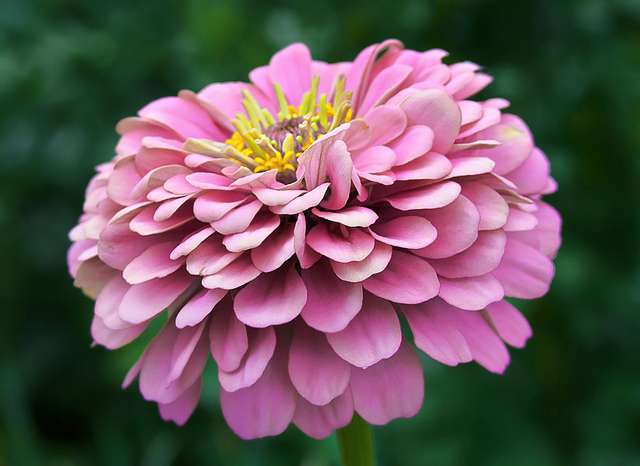

Zinnia blooms from June until the very cold weather, which it does not tolerate at all, and will die with the first frost. Has a weak spicy aroma, repels pests and attracts butterflies, bees, and other beneficial insects to the garden.
Interesting! Planting zinnia will create a favorable environment for pollination of various garden plants, they are melliferous, bees flock to them. Isn't this a virtue ?!
Botanical description of the plant
Zinnia (Zinnia) is a genus of annual and perennial grasses and shrubs of the Asteraceae family. The genus zinnia has 15-20 species native to Central and South America.
Zinnias are annual and perennial, herbaceous and semi-shrub plants.Leaves are ovate with a pointed apex, sessile, whole, opposite or whorled on the stem.
Zinnia inflorescences are baskets, solitary, relatively large, apical, on long, usually on top, thickened peduncles or sessile. The wrapping of the baskets is multi-row, tiled. The marginal flowers are ligulate, variously colored: yellow, red, white, pink, purple, lilac, densely arranged, with a rounded or notched limb; internal - small, tubular. Zinnia fruit is achene.
Two annual species are used in landscaping - Zinnia graceful (Zinnia elegans) and Zinnia angustifolia (Zinnia angustifolia). They gave rise to numerous varieties of garden zinnias, which are very diverse in decorative possibilities. Zinnias are especially popular in the United States. Most of the modern varieties were bred there. Americans love it for its heat resistance and bright color.

